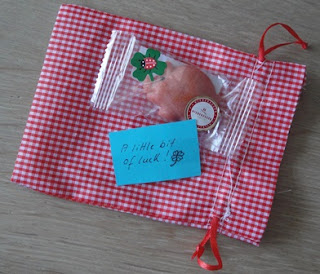Nadat ik het besluit had genomen om met de bouw van mijn
miniatuur boerderij in 1:12 te beginnen, kwam ook het plezier van miniatuur
werken maken terug, pfiew, wat een opluchting ;O!
Kleine Ikke brengt een bezoekje aan het toilet op de
boerderij (in de jaren ’50), Oma tilt haar er op want de closetpot is nog te
hoog voor haar lengte 8,5 cm (in het echt 1.02 meter)…
After I made the decision to start the build of my miniature
farm in 1:12, the fun of making miniature works came back to me, phew, what a
relief ;O!
Little Me is visiting the loo on the farm (in the 50s),
Grandma is lifting her up, because the lavatory bowl is just too high for her
length of barely 3 1/2 inch/1.02 meter (about 40 inch in RL)…
Ik heb een aantal onderdelen van het werkgedeelte van de
boerderij laten zagen bij de bouwmarkt, ook de muren en vloer van de wc. De
muren zijn, zoals gebruikelijk bij een oude boerderij, ‘gewit’, ik heb hiervoor
Gesso van Talens gebruikt. De gesso is met een varkensharen platte kwast van
boven naar beneden op de muren gestreken, zó dat je de penseelstreken goed kunt
zien. Na een dunne laag over de hele muur, heb ik de onderzijde op 5 cm afgeplakt met schilders tape. Daarna heb
ik dit herhaald op de bovenste delen van de muren, de gesso is dun uitgestreken
op een manier waarbij de muur een soort ‘transparantie’ krijgt.
At the sawing mill department of the DIY I asked for sawing
some parts for the farm, including the walls and the floor for the toilet. The
walls are 'whitewashed', as was common use for old Dutch farms. I've used white
Gesso from Talens. With a flat paintbrush (pigshair) the Gesso is painted from
above to downwards on the walls so that you can see the brush strokes. After
one complete layer over the whole surface and I taped off for 5 cm at the
underside of the walls with painters tape. Then the gesso is painted again in a
thin layer for the upperside of the walls, the way it seems like the wall get a
sort of ‘transparance’.
Om verschillende redenen werd de onderste 50 cm van de muren
van boerderijen zwart geschilderd. Dit heb in miniatuur vertaald door Talens
acrylverf in de kleur oxide zwart te gebruiken, de verf is karig opgebracht met
een goedkoop make-up sponsje. Door hier en daar wat minder verf te gebruiken
komen er vale plekken in de verf, waardoor je de muur een meer geleefd aanzien
kunt geven.
Voor de vloer heb ik krijtverf gebruikt in de kleur
houtskool, steengrijs en licht topaas.
The first 50 cm at the bottom of the walls from farms was
painted black for several reasons. In miniature I've translated this by using
acrylic paint from the brand Talens in the color oxid black, the paint is
applied with a cheap make-up sponge. By using more or less paint you can give
pale spots in the paint, this way you can give the walls a more used look.
For the floor I used chalkpaint in the colors charcoal, stonegrey
and light heliotopaz.
Zo zien de muren en vloer er na deze verfbeurten uit, nu beginnen
we met de riolering.
Wie niet goed tegen vieze luchtjes kan, kan dit stukje beter
overslaan òf……een wc verfrisser bij de computer zetten, hihihi ;O!
This is how the walls look now after getting these layers of
paint, now we'll start with the sewerage.
Those of you, who can't stand bad odors, can better skip
this part in reading, OR... you can put a toilet spray next to your computer,
hihihi ;O!
Aangezien de boerderij tot na de WO 2 een buitentoilet had,
is er binnen in de koestal tegen de buitenmuur een plaats voor een koe
opgeofferd ten bate voor het plaatsen van een echt toilet. Dat wil zeggen…..de
riolering was er niet en daarom werd het toilet aangesloten op de zogenaamde beerput.
Er was ook geen waterleiding dus werd er een grote email kan met water naast
het toilet gezet om door te spoelen. Over vieze luchtjes gesproken…..
Warm welkom aan mijn nieuwe volgers en dank voor jullie fijne reacties, fijne week allemaal!
Since the farm had an outdoor toilet until after WW 2, there
had to be sacrificed the space for one cow in the cowstable, it was the one
right next to the outside wall, all for the benefit of placing a real toilet
indoors. That is to say ...the sewerage had not yet been laid out during that
time and that's why the toilet was connected to the so-called cesspit. There
also was no waterworks in that time, so there was standing a large enamel water
jug next to the toilet for flushing. Speaking of dirty smells .....
Because this blogpost will be way too long to explain/show
everything now, I’ll write a blog soon again about the continuation of the
construction of the toilet. So next time keep the toilet spray at hand ;)!
Gracias/thanks to Pilar, for answering my question regarding
the glue J!
A warm welcome to my newest followers and thank you for your
kind comments, have a nice week!
Ilona



























































